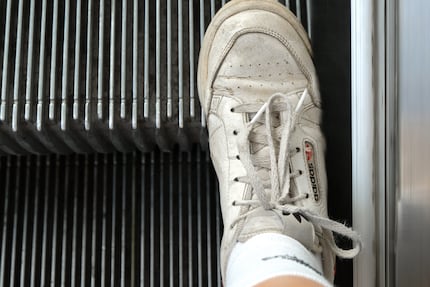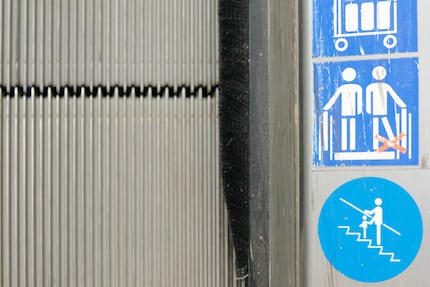
Guide
In five steps from pfui to hui: Bike shoe cleaning with Motorex
by Patrick Bardelli

Not only do escalators spare you the huffing and puffing of climbing up stairs, but they’re even equipped with a built-in shoe shiner. Why else would those bristles be there?
Proof of this year’s extremely dry summer is to be found on my shoes. A brown layer of dust covers the white leather. I’m at Zurich’s main train station, making my way up to platform 17 to catch the Interregio to Lenzburg. As I’m riding the escalator up to the platform, my gaze falls to the bristles below, fixed to the side of the escalator. I momentarily debate using them to clean my shoe, just like I used to when I was a kid. But my temptation is quickly overpowered by a thought of far greater significance.
Escalators have bristles. Why?

It turns out that the bristles have nothing to do with keeping your shoes clean. Even if I’m not the only one who uses them for that purpose. They’re for your safety. Schindler, a Swiss designer of escalators, attests to that fact. «There’s a gap between the skirt [the side of the escalator] and the moving step. It has to be this way so that the steps can move. But to minimise the risk of something getting caught in this gap, the escalator standard EN 115/1 specifies that from 2004 onward, new and replacement installations must have bristles.» The standard asserts that this requirement prevents escalator passengers (as escalator users apparently should be called) from standing too close to the sides and having their shoelaces pulled into the gap. Something that kept happening prior to 2004.
But why did the escalator world choose bristles in particular? This, too, is regulated in the escalator standard EN 115/1 in the finest officialese. «[The skirt guard] must be made from a fixed and a flexible part (i.e. bristles, rubber profiles).» Schindler Switzerland explains this somewhat more simply by saying that the flexible material prevents shoes from «sticking» to the sides if passengers do stand somewhat close to the edge.

So much for shining my shoes. I mean, first of all, the bristles don’t do a thorough job, and secondly, using them that way completely defeats their purpose. Worst case scenario, if I press my sneaks too hard against the bristles, my shoelace could still get caught in the gap of the escalator. So I end up changing my mind and board the Interregio with dirty shoes after all. The teenager in me is happy with that. Because as a teen, I used to put in a fair amount of effort to keep my shoes dirty and avoid having uncool, spotlessly white sneakers.
Why does the second hand of the Swiss railway clock pause before a new minute? Why is popcorn served at the movies? And why don’t beverage glasses go in the same bin as other glass? Everyday life is filled with intriguing questions, the answers to which I’m determined to find. If you have a burning question of your own but no time to research it, e-mail me. I like doing the dirty work.
My life in a nutshell? On a quest to broaden my horizon. I love discovering and learning new skills and I see a chance to experience something new in everything – be it travelling, reading, cooking, movies or DIY.
Interesting facts about products, behind-the-scenes looks at manufacturers and deep-dives on interesting people.
Show all